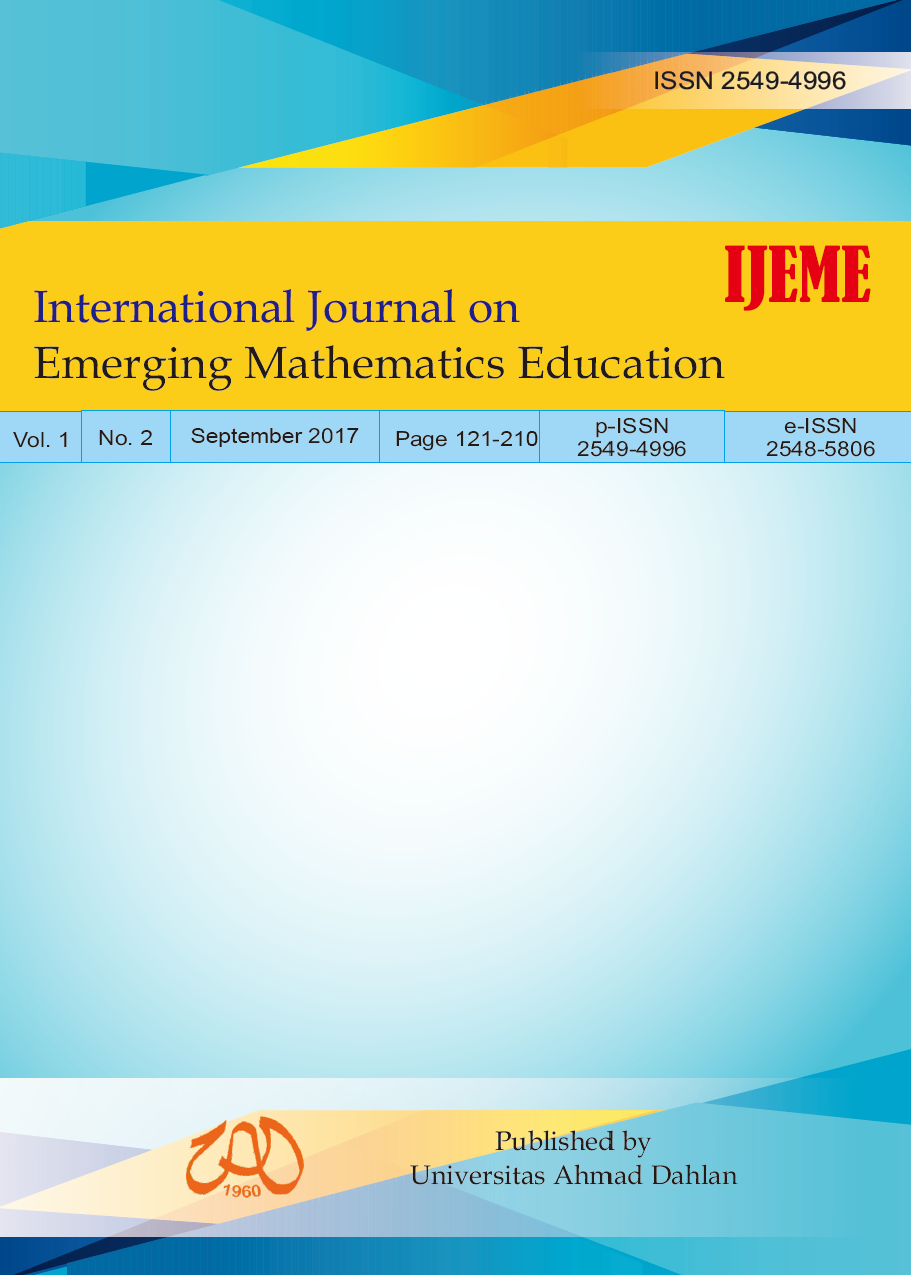Adversity Quotient in Mathematics Learning (Quantitative Study on Students Boarding School in Pekanbaru)
DOI:
https://doi.org/10.12928/ijeme.v1i2.5780Keywords:
adversity quotient, gender, metacognitiveAbstract
The aim of this study is to analyze students' Adversity Quotient (AQ) in mathematics learning viewed from gender aspect. This study is quantitative survey study on students in MTs Al-Munawarah Boarding School, Pekanbaru. The subjects of study are 8th grade students consisting of 75 girls and 63 boys. Data are collected by AQ scale and analyzed with statistic descriptive and inferential (test-t). The indicator of AQ consist of control, origin, ownership, reach and endurance. The result of descriptive analysis shows that there is difference in mean of each indicator for two groups, but analysis of test-t shows that there is no difference in students' mathematical AQ for two group of gender. Through variance test, students' mathematical AQ in two groups is homogeneous. The indicator of AQ in boys which is categorized as high are endurance and reach. While, the indicator in girls is aspect of control. This study contributes to literature study in identifying students' AQ and the effort done to enhance students' AQ in mathematics learning.References
Depdiknas. (2006). Peraturan Menteri Pendidikan Nasional Republik Indonesia Nomor 20 tahun 2006. Jakarta: Depdiknas.
Ernest, P. (1991). The Philosophy of Mathematics Education. London: Falmer
Gartmann, S., & Freiberg, M. (2012). Metacognition and mathematical Problem Solving: helping student to ask The Right Questions. Jurnal The Mathematics Educator, 6(1), 9-13.
Haralambos & Holborn. (2004). Sociology: Themes and Perspectives Sixth Edition. London: Harper Collins Publisher.
Kramarski, B., Mevarech, Z.R., & Arami, M. (2002). The effects of metacognitive instruction on solving mathematical authentic tasks. Educational Studies in Mathematics, 49(2), 225-250.
Matore, M.E.E.M., Khairani, A.Z., & Razak, N.A. (2015). The influence of AQ on the academic achievement among Malaysian Polytechnic students. International Education Studies, 8(6), 69-74.
MZ, Z.A. (2013). Perspektif gender dalam pembelajaran matematika. Marwah: Jurnal Perempuan, Agama Dan Gender, 12(1), 15-31.
MZ, Z.A., & Wahyudin. (2016). Exploration of metacognitive ability at elementary school students in learning mathematics (Case study in 1th Grade students of elementary school). Journal of Innovative Technology and Education, 3(1), 179-184.
MZ, Z.A., Wahyudin, & Turmudi. (2017). Metacognition think aloud strategies in setting cooperative think-pair-share/square to develop students' math problem solving ability (Comparative study on students of Madrasah Tsanawiyah Boarding/non-Boarding school in Pekanbaru). Advances in Social Science, Education and Humanities Research (ASSEHR), 57. Atlantis Press.
NCTM. (1989). Curriculum and Evaluation Standards For School Mathematic. Virginia: NCTM.
Nikam, V.B., & Uplane, M.M. (2013). Adversity quotient and defense mechanism of secondary school student. Universal Journal of Educational Research, 1(4), 303-308.
Pangma, R., Tayraukham, S., & Nuangchalerm, P. (2009). Causal factors influencing adversity quotient of twelfth grade and third-year vocational students. Journal of Social Sciences, 5(4), 466-470.
Parvathy, U., & Praseeda, M. (2014). Relationship between adversity quotient and academic problems among student teachers. IOSR Journal of Humanities and Social Science, 19(11), 23-26.
Prahmana, R.C.I., & Kusumah, Y.S. (2016). The hypothetical learning trajectory on research in mathematics education using research-based learning. Pedagogika, 123(3), 42-54.
Runisah, Herman, T., & Dahlan, J.A. (2017). Using the 5e learning cycle with metacognitive technique to enhance students' mathematical critical thinking skills. International Journal on Emerging Mathematics Education, 1(1), 87-98.
Schoenfeld, A.H. (1992). Learning to think mathematically: Problem solving, metacognition, and sense-making in mathematics. In D. Grouws (Ed.), Handbook for Research on Mathematics Teaching and Learning (pp. 334-370). New York: MacMillan.
Schraw, G. (1998). Promoting general metacognitive awareness. Instructional Science, 26(1), 113-125.
Sriyanto. (2007). Strategi Sukses Menguasai Matematika. Jakarta: PT. Buku Kita.
Stoltz, P.G. (2006). Editors. T. Hermaya. Adversity quotient mengubah hambatan menjadi peluang. Jakarta: PT Gramedia Widia sarana Indonesia.
Stoltz, P.G. (2010). Adversity Quotient Work: Finding Your Hidden Capacity For Getting Things Done. New York: Harper Collins.
Sweeney, C.M. (2010). The metacognitive functioning of middle school student with and without learning disabilities during mathematical problem solving. Dissertations. Miami: University of Miami.
Downloads
Published
How to Cite
Issue
Section
License
License and Copyright Agreement
In submitting the manuscript to the journal, the authors certify that:
- They are authorized by their co-authors to enter into these arrangements.
- The work described has not been formally published before, except in the form of an abstract or as part of a published lecture, review, thesis, or overlay journal. Please also carefully read the International Journal on Emerging Mathematics Education (IJEME) Author Guidelines at http://journal.uad.ac.id/index.php/IJEME/about/submissions#authorGuidelines
- That it is not under consideration for publication elsewhere,
- That its publication has been approved by all the author(s) and by the responsible authorities, tacitly or explicitly, of the institutes where the work has been carried out.
- They secure the right to reproduce any material that has already been published or copyrighted elsewhere.
- They agree to the following license and copyright agreement.
Copyright
Authors who publish with the International Journal on Emerging Mathematics Education (IJEME) agree to the following terms:
- Authors retain copyright and grant the journal the right of first publication with the work simultaneously licensed under a Creative Commons Attribution License (CC BY-SA 4.0) that allows others to share the work with an acknowledgment of the work's authorship and initial publication in this journal.
- Authors are able to enter into separate, additional contractual arrangements for the non-exclusive distribution of the journal's published version of the work (e.g., post it to an institutional repository or publish it in a book), with an acknowledgment of its initial publication in this journal.
- Authors are permitted and encouraged to post their work online (e.g., in institutional repositories or on their website) prior to and during the submission process, as it can lead to productive exchanges, as well as earlier and greater citation of published work.
![]()
Ciptaan disebarluaskan di bawah Lisensi Creative Commons Atribusi-BerbagiSerupa 4.0 Internasional.





